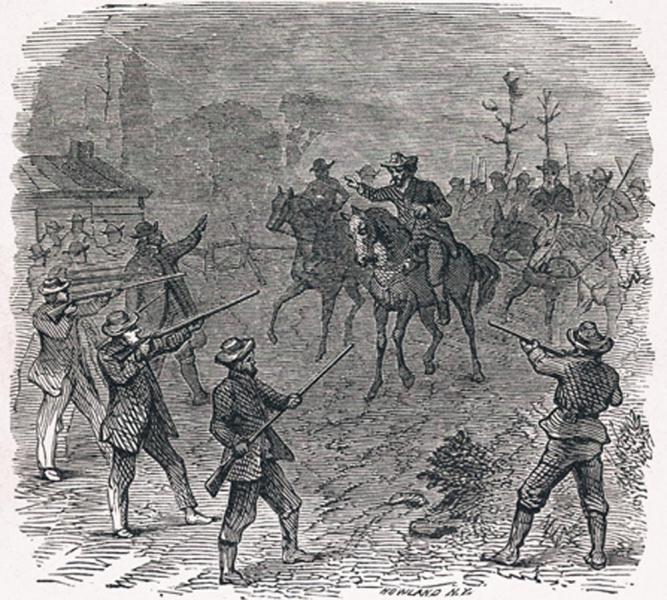By Tony R. Mullis, U. S. Army Command and General Staff College
Event Summary:
- Date: November 21 to December 8, 1855
- Location: Lawrence, Douglas County, Kansas
- Adversaries: Free-Staters vs. proslavery militia
- Casualties: Two Free-Staters killed
- Result: Resolved by a negotiated peace settlement
On November 21, 1855, Kansas resident Franklin Coleman (who happened to be proslavery) murdered Charles Dow (a Free-Stater) over a land dispute near Hickory Point, several miles south of Lawrence. Jacob Branson, the owner of the disputed property, recovered Dow’s body some four hours after the murder. Coleman argued that he acted in self-defense, but his actions sparked a political firestorm. Politics had not motivated Coleman to kill Dow, but the murder marked the genesis of the violent political divisions that characterized Kansas for the next 10 years.
Once Douglas County Sheriff Samuel J. Jones, a staunch proslavery advocate, learned of the events at Hickory Point, he led a posse to the area to restore order. Jones eventually arrested Branson on November 26 for disturbing the peace, but Dow’s murderer, Coleman, went free. Once word of Branson’s arrest spread, local Free-Staters formed a posse, rescued Branson, and took the fugitive to Lawrence. Sheriff Jones asked Governor Wilson Shannon to call out the territorial militia to aid him in the arrest of Branson’s rescuers.
Shannon mobilized the Kansas militia the following day, but the governor’s decision exacerbated the already volatile situation. The militia that responded to Shannon’s order consisted of as many as 2,000 Missourians. Their objective was not law enforcement but the destruction of Lawrence. Free-Staters formed their own units to protect their town. Ironically, Branson had departed, but the Missourians were determined to eradicate the Free-State community.
The militia was postured to lay waste to Lawrence if its proslavery leaders ordered an assault.
By December 1, Shannon realized his action had legitimized a potentially lethal proslavery monster. Any potential encounter between the militia and Free-State forces could trigger a civil war. Shannon sought advice from his militia commanders. They recommended that he ask Colonel Edwin Sumner, Fort Leavenworth’s commander, to intervene with federal troops. Shannon telegraphed President Franklin Pierce, seeking authority to use the army to resolve the situation. Sumner wondered why Shannon had not asked for federal troops in the first place. The colonel wanted to assist Shannon, but he would not use the army in a domestic dispute without orders from Washington. Shannon received Pierce’s reply “to use all power under his command” to enforce the laws on December 4, 1855, but Sumner still had no orders from the War Department and he refused to act without them.
Meanwhile, around 100 armed men, probably Clay County Volunteers, raided the Liberty Arsenal in Missouri for weapons to support the proslavery militia efforts. Once Sumner heard of the raid, he dispatched a company to investigate and to protect the arsenal. The company arrived on December 7, and it remained through Christmas without further incident.
Bear him, comrades, to his grave;
Never over one more brave
Shall the prairie grasses weep,
In the ages yet to come,
When the millions in our room,
What we sow in tears, shall reap.
Bear him up the icy hill,
With the Kansas, frozen still
As his noble heart, below,
And the land he came to till
With a freeman's thews and will,
And his poor hut roofed with snow.
One more look of that dead face,
Of his murder's ghastly trace!
Tensions along the Wakarusa River near Lawrence remained high. Shannon was unsure how to resolve the potentially explosive circumstances. The militia was postured to lay waste to Lawrence if its proslavery leaders ordered an assault. Shannon met with the Lawrence Committee of Safety on December 4. Two days later, he did the same with the militia leadership, including David Rice Atchison, in hopes of preventing bloodshed.
Shannon returned to Lawrence on December 7, the same day a band of Free-State supporters arrived with the body of the second person killed during the Wakarusa War. The murdered Free-Stater was Thomas Barber. A proslavery patrol led by Pottawatomi Indian Agent George W. Clarke intercepted and exchanged gunfire with a small band of Free-Staters that included Barber on December 6. After Clarke mortally wounded Barber, both parties left the scene. Barber’s death enraged Free-Staters, but Shannon’s timely intervention prevented escalation.
Fortunately, Shannon’s negotiations and the bitter temperatures cooled both sides. A peace treaty signed on December 8 provided a temporary halt in what would grow into a 10-year ordeal. Future Kansas senator James Lane and future Kansas governor Charles Robinson signed the agreement for the Free-State supporters, while Atchison and other proslavery leaders acknowledged the agreement for the proslavery element.
With a minimal level of actual violence, the Wakarusa War was not a war by traditional definitions. The necessary ingredients for war were certainly present, but Shannon’s timely negotiations, the weather, and perhaps a rational fear of what might happen if a battle occurred led to a non-violent, albeit temporary, resolution of the conflict between Free-Staters and proslavery supporters.
Suggested Reading:
Etcheson, Nicole. Bleeding Kansas: Contested Liberty in the Civil War Era. Lawrence: University Press of Kansas, 2004.
Mullis, Tony R. Peacekeeping on the Plains: Army Operations in Bleeding Kansas. Columbia: University of Missouri Press, 2004.
Cite This Page:
Mullis, Tony. "Wakarusa War" Civil War on the Western Border: The Missouri-Kansas Conflict, 1854-1865. The Kansas City Public Library. Accessed Friday, April 19, 2024 - 11:55 at https://civilwaronthewesternborder.org/encyclopedia/wakarusa-war


